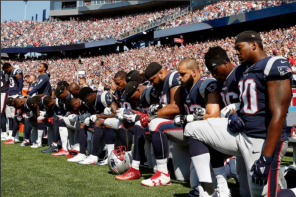This past Friday night, San Francisco 49ers quarterback Colin Kaepernick made the audacious choice to remain seated during the playing of the national anthem as a form of political protest against police violence and racism in America.
The response against him has been swift, angry, and in many cases ugly. A series of commentators—mostly in the athletic and political spheres—lined up to rebuke him. So did the general public. For a taste of the sort of vitriol Kaepernick’s action inspired, simply scan the comments from online news reports, which call him un-American, selfish, naïve, treasonous, and dangerous.
Donald Trump even laid into him, “I think it’s a terrible thing, and you know, maybe he should find a country that works better for him.”
As a scholar of religion what interests me in this instance is the power of the flag as symbol—particularly in the way that people have reacted. To help understand this level of outrage, I turn to theorist of religion Émile Durkheim (1858-1917) who foretold this sort of controversy over a hundred years ago in his famous text, The Elementary Forms of Religious Life.
Rightly or wrongly, Durkheim centered his model of religion on the concept of the totem, “the material representation of the clan,” which over time becomes a sacred object and center of a tribal religion.
Within this model of religion, the totem serves as the preeminent symbol of the group. “Thus the god of the clan […] can be none other than the clan itself, but the clan transfigured and imagined in the form of the plant or animal that serves as totem.” What plants or animals did for ancient societies, flags do today. The totemic symbol of America, the American flag, represents the nation state as a sacred entity—it serves as symbolic referent point for the nation’s self-worship.
From this perspective, what else is the national anthem but a hymn to the nation, and what else did Kaepernick do but thumb his nose at American civil religion by sitting down in church while the choir sang?
For his part, Kaepernick was clear about why he opted not to stand. He released a statement through the official NFL Media wing:
I am not going to stand up to show pride in a flag for a country that oppresses black people and people of color. To me, this is bigger than football and it would be selfish on my part to look the other way. There are bodies in the street and people getting paid leave and getting away with murder.
In a very Durkheimian manner, Kaepernick intentionally violated the taboos against sitting—or if one prefers, the ritual of standing—associated with the national totem.
We can read the response through Durkheim too. This early twentieth-century theorist warned of the power of the totem in massive social settings wherein the people’s collective passions, what he called “effervescence,” could lead individuals to act with emotional abandon, what we today might call extremism.
To threaten the totem, particularly in front of large groups (such as on national television!), is to call into question the foundations of society. “When a belief is shared unanimously by a people, to touch it—that is, to deny or question it—is forbidden,” Durkheim wrote. People kill or die for their symbols:
The soldier who dies for his flag dies for his country, but the idea of the flag is actually in the foreground of his consciousness […] Although the country will not be lost if a solitary flag remains in the hands of the enemy or won if it is regained, the soldier is killed retaking it. He forgets that the flag is only a symbol that has no value in itself…
Had Durkheim written today, he might have invoked the imagery of the raising of the flag over Iwo Jima, one of the most important iconographic representations of the American nation state at heroic war; or he might have considered debates over flag burning and desecration, and the uncountable dollars and hours spent in court battles over what is “only” a piece of cloth.
Or he might have invoked Kaepernick, who dared to challenge the meaning of the flag and in doing so challenged the “reality” behind it.
So as some wonder why Kaepernick couldn’t just stand up quietly during the national anthem, or why the response to his actions was so heated and even hateful, Durkheim’s theory of religion looms large.
If we wanted proof of the robustness of American civil religion—with its totem of a flag and hymn-like national anthem—the public flare-up that greeted Kaepernick’s dissent offers a powerful reminder.





